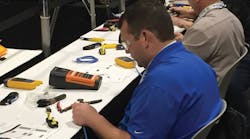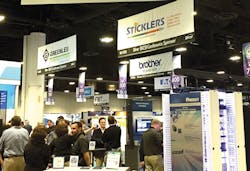Held from January 22 to January 26 at the Tampa Convention Center in Tampa, Fla., the BICSI 2017 Winter Conference offered the latest concepts relating to the design and application of communications networks and their support systems. At the same time, the demands being made on copper and optical fiber cabling are fostering new ideas in cable constructions and typologies, and in the development of new or revised BICSI standards.
A key theme for the conference was infrastructure solutions for the Internet of Things (IoT) and Intelligent Building Integration. IoT will have a significant impact on the commercial real estate industry, as these firms move beyond focusing just on cost reduction. IoT applications can help building owners grow their margins by introducing features that improve the efficiency of power-consuming machines, enhance tenant relationships, while also creating new revenue opportunities. Connected building systems, linked to a modern building management platform, can continually modify conditions in response to occupancy, air temperature, humidity, personal preferences, and other environmental factors.
For example, Verdigris Technologies, a four-year-old San Francisco company, is using artificial intelligence to collect information from the electrical panels of buildings owned by its 20 active customers, and then analyze these “fingerprints” for any opportunity to optimize setting while also predicting possible maintenance issues that boost power consumption.
A main driver in the adoption of IoT is the Power over Ethernet (PoE) technology, which uses a network switch as an LED driver, communications cable (Cat. 5, Cat. 6, Cat.6A, and above) to create the network, and luminaires with an RJ45 port to connect to the network. Although a number of competing systems exist, PoE is gaining the most attention, with switch maker Cisco promoting its Digital Ceiling Framework concept. To foster communication among devices, Cisco is using the open standard Sensor Markup Language (SenML), similar to the web’s HTML. Just as HTML provides a universal language for webpage developers, independent of server or client platform, SenML allows anyone to create apps and devices that work in the Digital Ceiling Framework domain.
A number of concerns accompany the broadening use of PoE, such as the fact that a communications cable delivering DC power can generate considerable heat. At levels above 60W, the heat rise for a 100-cable bundle using PoE can be greater than its listed rating, thus causing a reduction in transmission performance, cable degradation and, in extreme cases, creating hazardous fire conditions.
Cable insertion loss de-rating should also be understood, as well as the fact that when unplugging an active PoE circuit, an arc (or spark) occurs between the plug and jack contacts. Therefore, connectors, patch cords, cross-connect wiring, patch panels, and consolidation points also require extended operating temperature specifications.
The Exhibit Hall at the Winter Conference featured a New Product Pavilion, with a “Best in Show” section, and Building Systems Solutions was one of the six categories on display.
Educational session highlights
In “Best Practice for Networking Intelligent Devices: Zone Cabling and Coverage Area Planning,” Valerie Maguire, Siemon, discussed the standard for Building System Cabling: ANSI/TIA 862-B, which cites zone cabling as a recognized application supporting the convergence of data, voice, building devices, and wireless networks. In addition, the use of LED lighting systems served from balanced twisted-pair Ethernet cabling carrying low-voltage DC power, such as PoE, is adding to the popularity of zone cabling.
Zone cabling supports data and voice networks and a wide range of equipment used in a building. It includes the horizontal cables run from the floor distributor in the telecommunications room (TR) to an intermediate connection point, typically housed in a zone enclosure in a ceiling plenum, on the wall, or below an access floor. The nomenclature used depends on the cabling standard being referenced and the types of end-point device used.
Generally, PoE luminaires should have their own dedicated zone enclosures. In addition, solid conductor cables are recommended because stranded conductor cables typically have higher DC resistance and generally have reduced transmission performance at elevated temperatures.
In “Infrastructure Challenges and Solutions for IoT and Intelligent Buildings Integration,” Carol Everett Oliver, Legrand, North America and Furukh Aslam, Sinclair Holdings LLC, described the Internet of Things (IoT) as a network of uniquely identifiable endpoints (or things) that contain embedded technology to sense, collect, communicate, and exchange data locally or with external equipment.
An intelligent building has the potential to provide a safer, more comfortable and more productive environment for its occupants and visitors. These devices include: low-voltage LED lighting, wireless access points, occupancy sensors and Internet-based thermostats, building management systems, sound masking, digital signage, intercoms, and security cameras.
The three network architectures to consider are:
1) Centralized, where analysis, storage, and computing of the applications take place;
2) Decentralized, where the computing is handled at the edge of the application and gateways are used to deliver data, and network latency does not interfere with performance and reliability; and
3) Hybrid, where parts of both centralized and decentralized layouts are used. Typically, non-critical information is sent to a data center for storage.
An important consideration in setting up a PoE network that connects to devices in a building is defining the type of cable (or Category) to use when delivering both power and data over a standard Ethernet network. Many of the devices currently being specified do not fit the typical structured cabling model (as defined by TIA) and both the TIA and BICSI are studying these design and installation challenges.
In “Build Smart not Hard – the Application of Technology in Today’s Smart Building Environment,” Joseph E. Ford and Anthony Frassetta, Burns Engineering, explained the concept of a “smart building,” which is also called “an intelligent building.” In the past, the energy-efficiency advantages of a smart building was considered the most important asset; however, companies are starting to see how mobile apps and a holistic approach to serving the occupants of a commercial building can increase employee productivity, engagement, and satisfaction. Thus, a smart building should optimize four basic components: structure, systems, sensors, and management. Specific benefits include: a reduction in energy consumption (i.e., lower utility costs), lower capital cost from increased equipment life, decreased unplanned downtime, lower risk of equipment failure, and the ability to reuse rentable floor space for added revenue. An intelligent building can also reduce the initial cost of a new building 10% to 15% and reduce the cost of IT cabling and pathways up to 30%.





